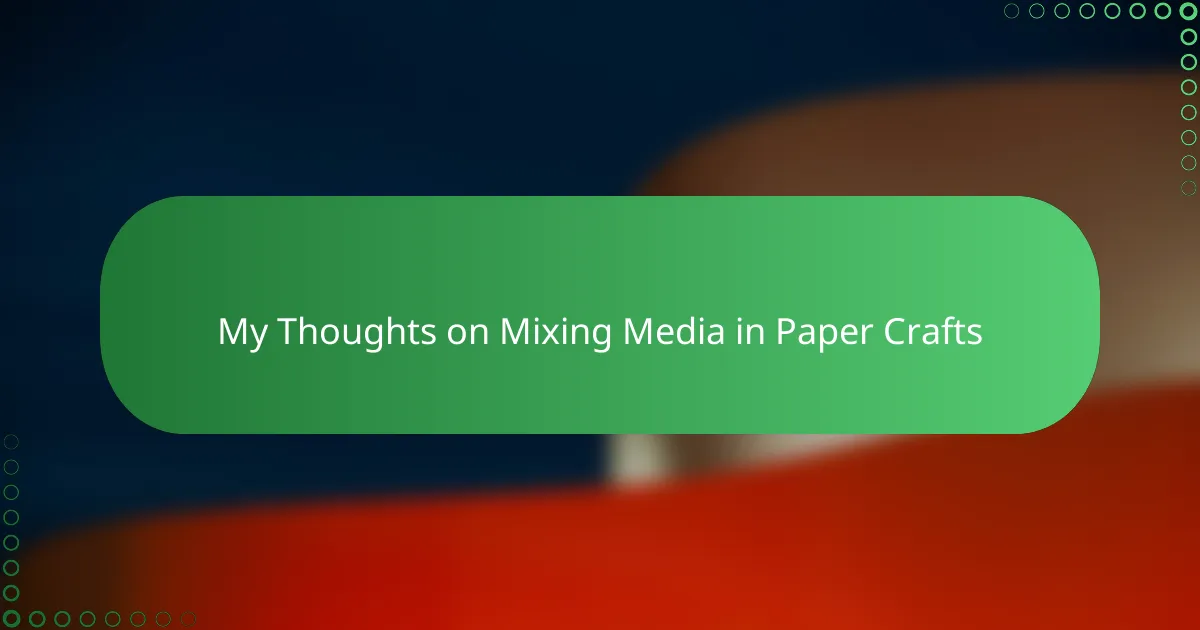Key takeaways
- Handmade paper’s unique texture demands patience and respect, enhancing creativity and personal expression.
- Understanding material interactions and allowing adequate drying time are crucial for successful mixed media projects.
- Embrace imperfections, as they often lead to unexpected and beautiful results in artistry.
- Lighting, framing, and storytelling are vital when showcasing mixed media crafts, enhancing viewer engagement and appreciation.
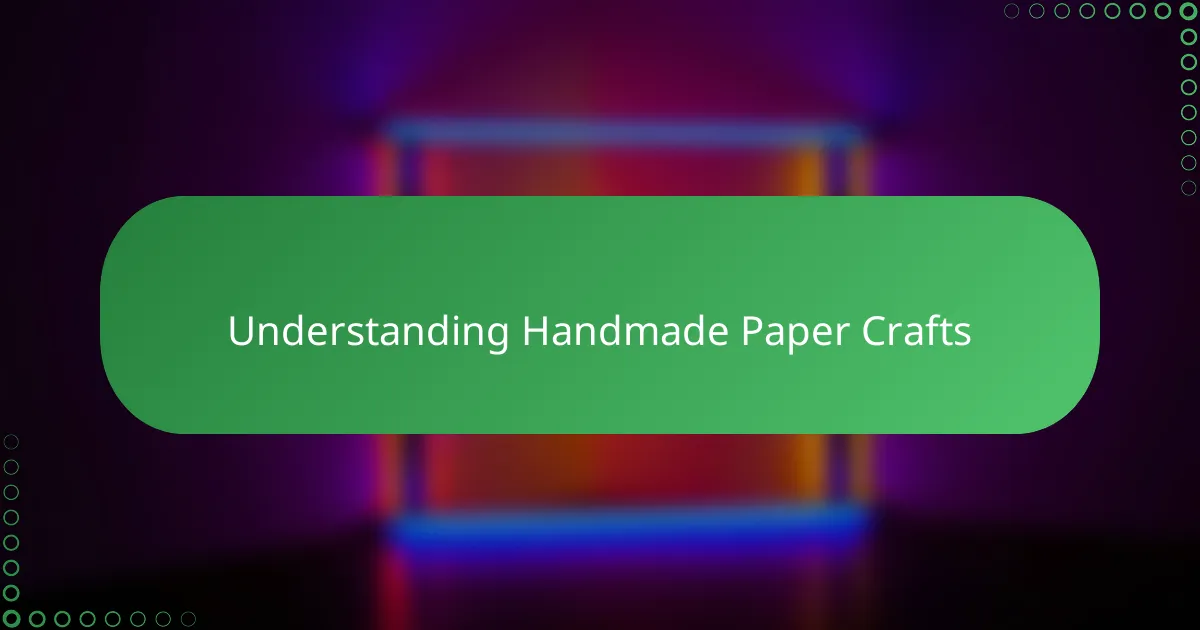
Understanding Handmade Paper Crafts
Handmade paper crafts have a unique charm that machine-made paper just can’t replicate. I remember the first time I held a piece of handmade paper—its texture was rough yet delicate, full of tiny imperfections that told a story. Have you ever noticed how those little irregularities make each sheet feel alive, almost as if it’s whispering its own history?
Working with handmade paper is like partnering with an unpredictable friend. Unlike smooth, factory-produced paper, handmade sheets demand patience and respect. I often find myself adjusting my techniques to honor the paper’s natural fibers and movements, which adds a layer of intimacy to my creative process.
What truly fascinates me is how the spirit of handmade paper transforms the entire craft. It acts as more than just a base; it invites innovation and personal expression. Don’t you think that when we understand this, our creations become not just objects, but stories woven with both hand and heart?
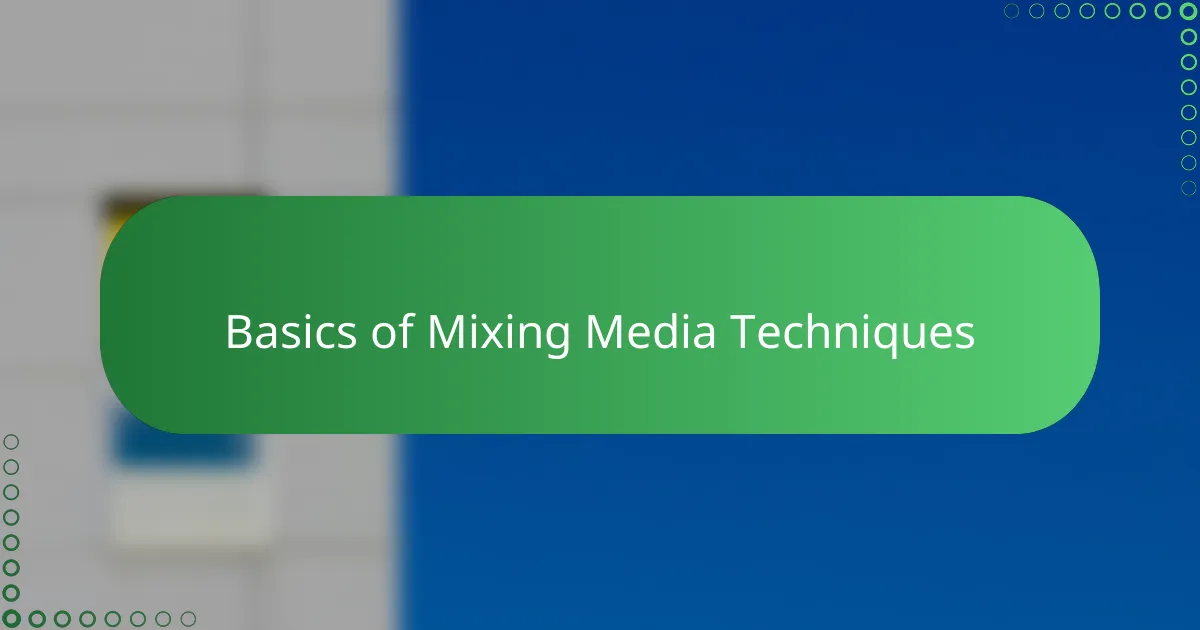
Basics of Mixing Media Techniques
When I first started mixing media on handmade paper, I quickly learned that understanding how different materials interact is key. For example, some inks soak right into the fibers, while others sit on top, creating fascinating textures. Have you ever tried layering paint over ink and watched how each medium reacts differently? It’s like a little science experiment every time.
I also discovered that the order in which you apply your materials can completely change the outcome. Applying a wet medium over a dry one gives a crisp effect, whereas blending wet layers can create soft, dreamlike transitions. Figuring out these nuances felt like unlocking a secret language between the paper and my tools.
One thing that surprised me was how experimenting with mediums taught me to embrace unpredictability. Not all spreads turn out perfect, but those unexpected results often spark my most creative ideas. Isn’t it incredible how the imperfections in handmade paper become an essential part of the magic when mixing media?
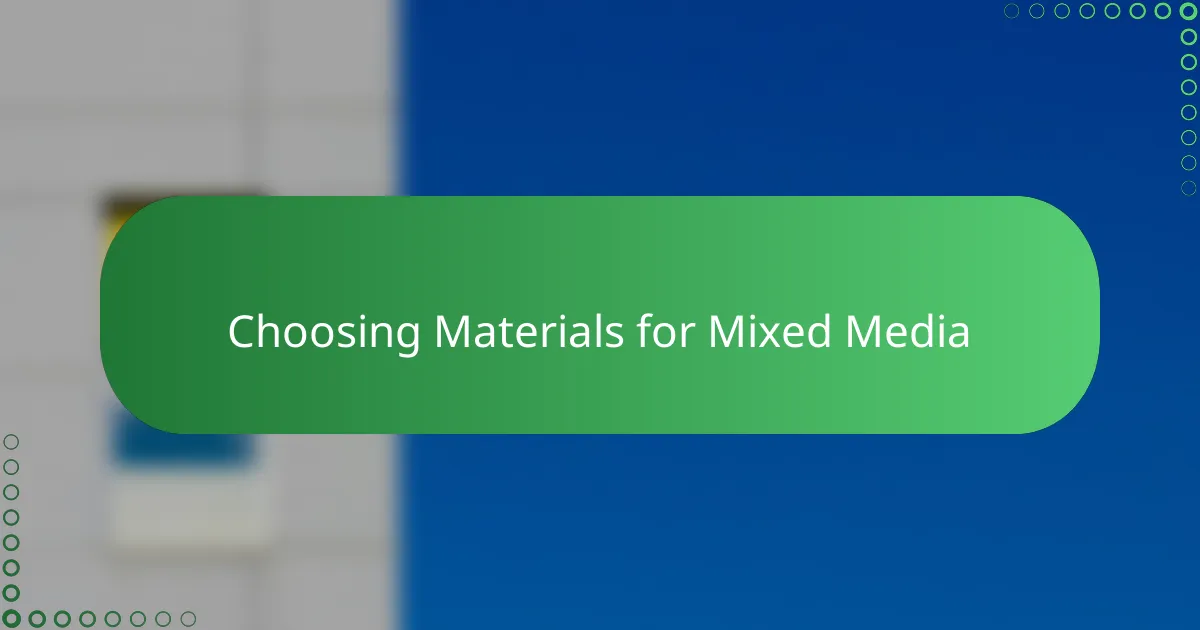
Choosing Materials for Mixed Media
Choosing materials for mixed media on handmade paper is an adventure in itself. I usually start by testing how different paints, inks, and adhesives behave on the textured surface—sometimes, a seemingly perfect combination ends up bleeding or curling the paper. Have you ever felt the excitement and frustration of that delicate balance between the materials and your base?
One of my favorite go-to materials is watercolor because it respects the paper’s absorbency, allowing the fibers to breathe without warping. But I also love incorporating unexpected elements like fabric scraps or thin metal pieces; they add dimension and invite curiosity, though they require careful consideration of weight and adhesion. It’s a bit like building a tiny ecosystem where every component needs to coexist harmoniously.
I’ve learned that patience is crucial when choosing materials. Rushing into layering without knowing how each item will interact can lead to disappointing results. Have you ever waited hours just to see if a medium dried properly before moving on? That waiting period, though slow, often leads to the most rewarding surprises in mixed media creations.
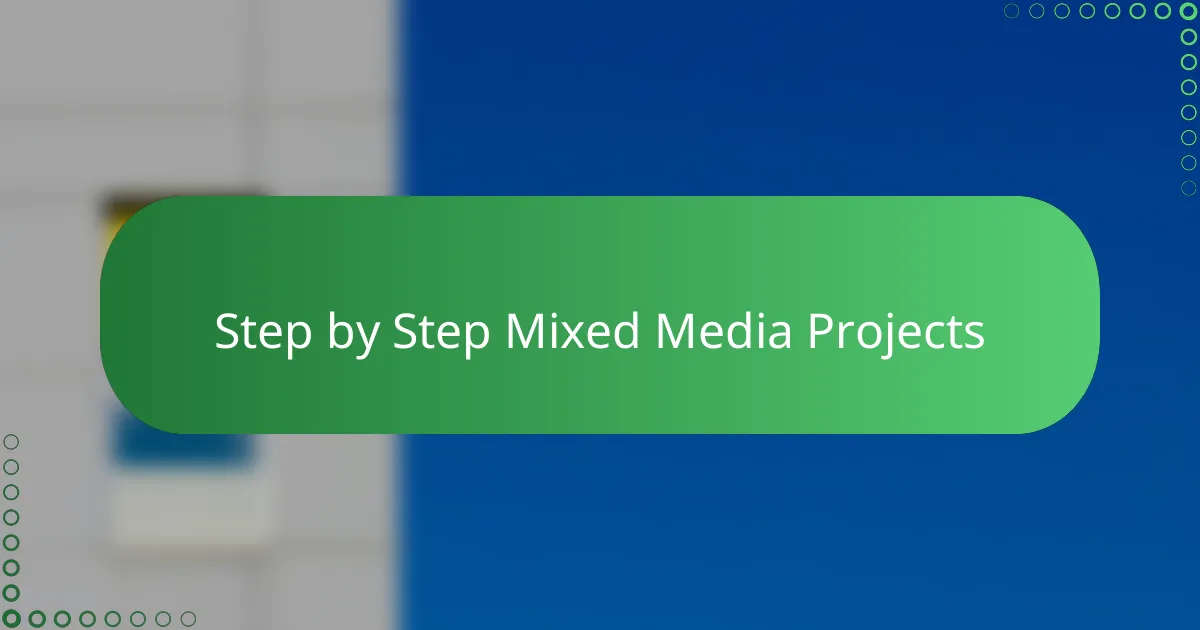
Step by Step Mixed Media Projects
One time, I tackled a mixed media project by breaking it down into clear, manageable steps—starting with sketching a basic design directly on the handmade paper. Have you ever noticed how taking that slow, deliberate first step grounds the entire process? It’s like setting the stage for whatever comes next, ensuring the layers build harmoniously rather than chaotically.
Next, I usually layer my chosen paints or inks, pausing to let each layer dry before adding textures like tissue paper or thread. Waiting can be tough—I’ll admit I often feel the urge to rush—but those pauses have taught me the value of patience and how it transforms the final piece. Don’t you think that those moments of stillness bring a kind of intentional magic to handmade paper?
Finally, sealing the project with a gentle adhesive or varnish feels like putting a protective hug around all those delicate layers. Sometimes, I surprise myself by how each element—from the rough fibers of the paper to the shiny highlights of the paint—comes together in a way I never fully planned but completely love. Isn’t that spontaneous joy why mixed media projects keep pulling us back for more?

Common Challenges and Solutions
One challenge I often face when mixing media on handmade paper is controlling warping or buckling, especially when using wet materials. I’ve found that pressing the paper gently between clean, absorbent sheets as layers dry helps keep it flat—have you tried that method? It’s a simple trick, but it saves so much frustration.
Adhesion issues can be another stumble. Sometimes glue or paint just won’t stick the way I imagined, leaving elements loose or peeling. Over time, I learned to test adhesives on small scraps first and adjust the amount I use, which turned out to be a game-changer for maintaining the piece’s integrity.
Then there’s the unpredictability of color bleeding or smudging—a double-edged sword that can either add unexpected beauty or ruin details. I’m continually reminded that patience and experimentation are key; letting each layer dry fully before the next step not only prevents mess but also opens up new creative possibilities. Have you found that waiting turns “mistakes” into happy accidents? I sure have.
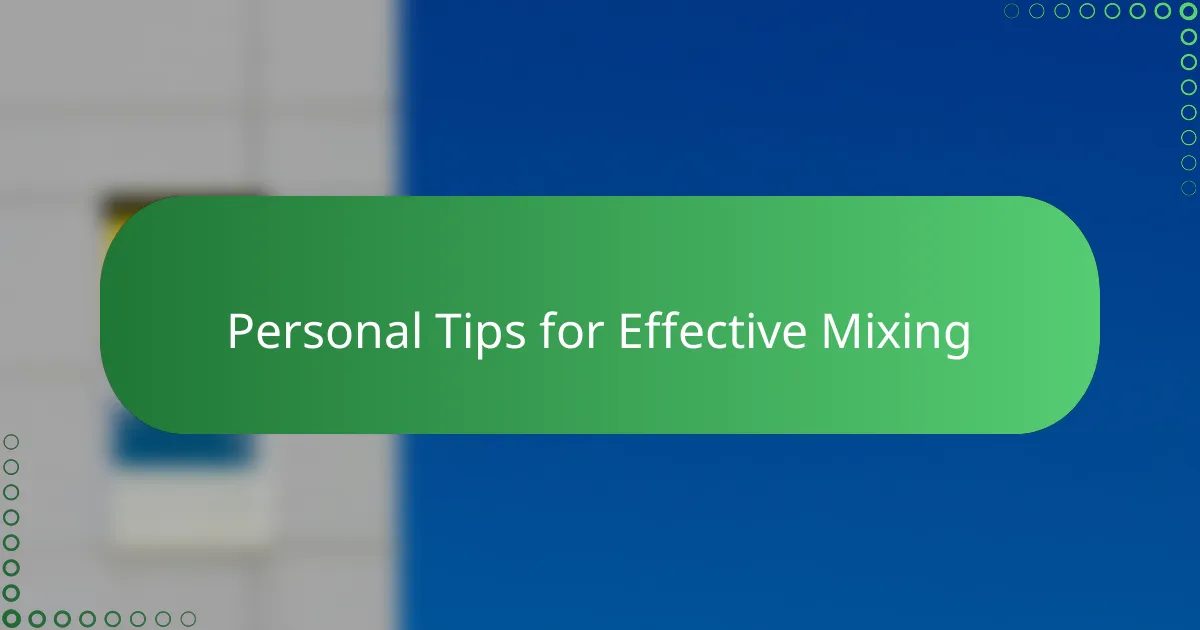
Personal Tips for Effective Mixing
When I mix media on handmade paper, one tip that never fails me is to respect each material’s drying time. I used to rush layers, eager to see the final result, only to end up with smudges and muddled colors. Have you ever learned the hard way that patience actually enhances your work? Waiting between layers feels like a quiet conversation with the paper, letting every element settle comfortably.
Another thing I’ve discovered is that less is often more. I once overloaded a piece with too many textures and paints, thinking it would look richer. Instead, the chaos distracted from the beauty of the handmade paper’s subtle texture. Now, I carefully select just a few complementary media, allowing the paper’s character to shine through. Doesn’t simplicity sometimes create the most powerful statements?
Finally, I’ve found it invaluable to keep a small notebook where I jot down combinations that worked or failed. There’ve been moments when I struggled to replicate a lovely effect, but my notes saved the day. Do you keep track of your experiments? Reflecting on past successes and mistakes makes mixing media feel less like a guessing game and more like a personal craft journey.
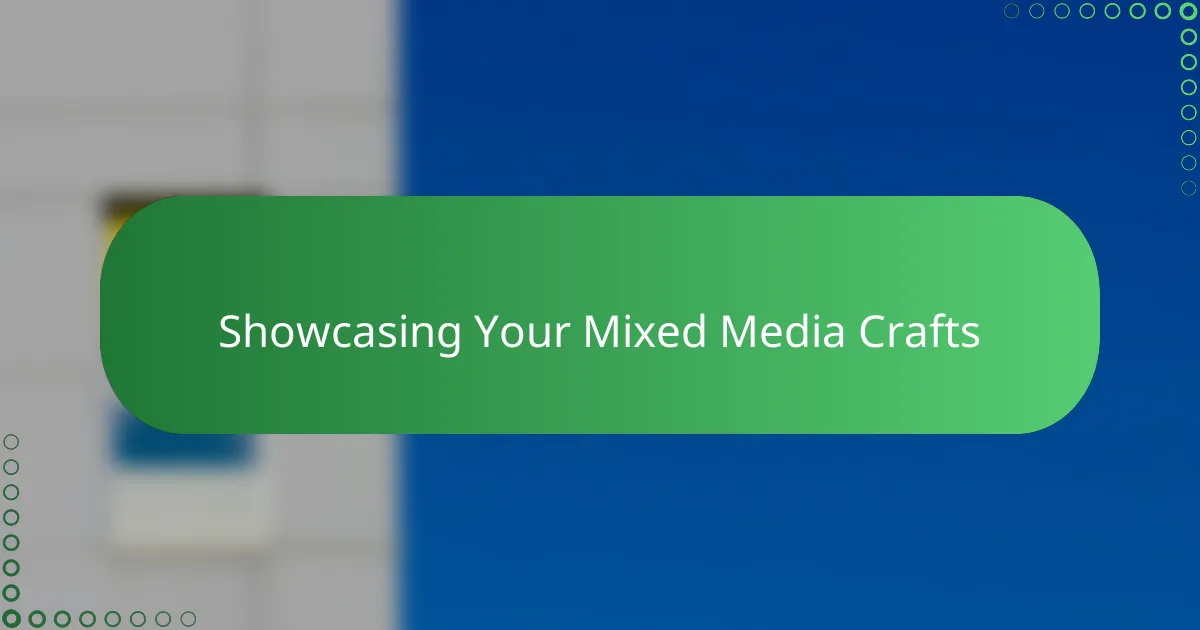
Showcasing Your Mixed Media Crafts
When it comes to showcasing mixed media crafts, I’ve noticed that lighting can make or break the viewer’s experience. I once displayed a piece under harsh lighting that flattened all the textures I had carefully built up, which felt like a missed opportunity to reveal the layers’ depth. Have you found that the right light seems to breathe life into your work, highlighting every contour and detail just as you intended?
Framing is another detail I’ve grown to appreciate—choosing a frame that complements rather than competes with the mixed media elements is an art in itself. Sometimes I go for simple, natural wood frames that echo the handmade paper’s organic feel, while other times a bold, modern frame creates a striking contrast. Finding that balance feels a bit like dressing your craft for its gallery debut, don’t you think?
I also cherish sharing my creations in intimate settings, like craft fairs or small exhibitions, where I can tell the story behind each layered technique. Those moments of connection, when someone asks about the textures or materials, remind me why showcasing isn’t just about presentation—it’s about inviting others into the dialogue between the paper, the mediums, and the maker’s hand. Isn’t that the true joy of handmade mixed media art?
